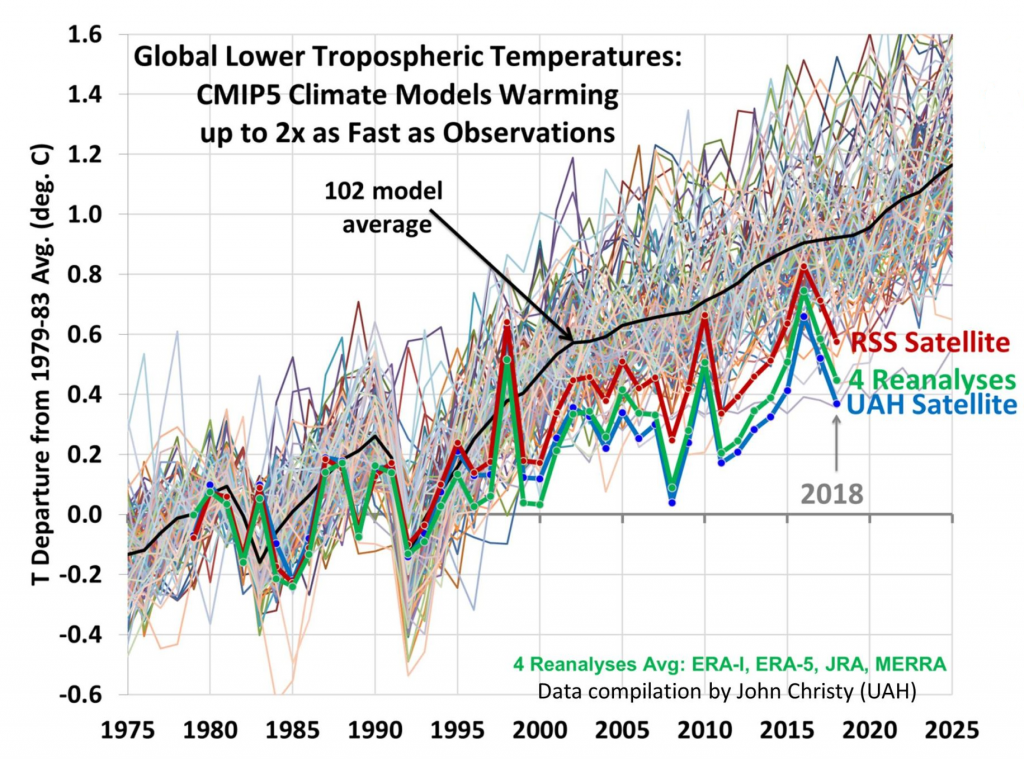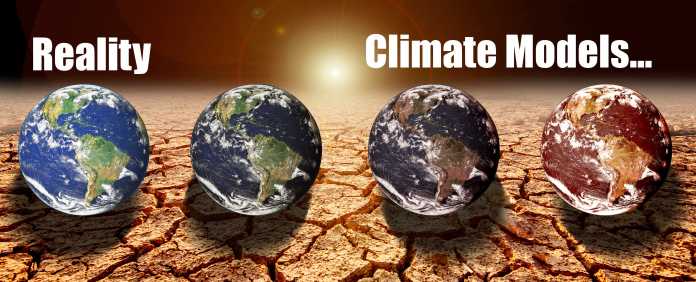In a new report, some climate scientists are putting the brakes on future warming and say other researchers should avoid suspect climate models. This research confirms what Climate Realism first reported in August 2021, the climate model Representative Concentration Pathway 8.5 (RCP8.5) produces “implausibly hot forecasts of future warming.”
Now a group of climate scientists argues in a commentary published recently in Nature, researchers should no longer use the average of all the climate model projections, which contains Representative Concentration Pathway 8.5 (RCP 8.5), the highest emission scenario ever used. They say this can result in global temperature projections by 2100 up to 0.7°C warmer than an estimate from the Intergovernmental Panel on Climate Change (IPCC). An example is seen in Figure 1 below.

The lead author of the study commented in an article in Science magazine, titled “Use of ‘too hot’ climate models exaggerates impacts of global warming.”
“We need to use a slightly different approach,” said Zeke Hausfather, lead author of the commentary. “We must move away from the naïve idea of model democracy.”
Instead, he and his colleagues call for a model meritocracy, prioritizing, at times, results from models known to have more realistic warming rates.
From the article:
The problem of the too-hot models arose in 2019 from the Coupled Model Intercomparison Project (CMIP), which combines the results of the world’s models in advance of the major IPCC reports that come out every 7 or 8 years. In previous rounds of CMIP, most models projected a “climate sensitivity”—the warming expected when atmospheric carbon dioxide is doubled over preindustrial times—of between 2°C and 4.5°C. But for the 2019 CMIP6 round, 10 out of 55 of the models had sensitivities higher than 5°C—a stark departure. The results were also at odds with a landmark study that eschewed global modeling results and instead relied on paleoclimate and observational records to identify Earth’s climate sensitivity. It found that the value sits somewhere between 2.6°C and 3.9°C. The divergence in sensitivity estimates is a “sobering example of the complexity of the climate system,” says Christopher Field, a Stanford University climate scientist who focuses on impacts.
Researchers have since tracked down the causes of the too-hot models, which include those produced by the National Center for Atmospheric Research, the U.S. Department of Energy, the United Kingdom’s Met Office, and Environment and Climate Change Canada. They often relate to the way models render clouds; one result has been excessive predicted warming in the tropics.
This mirrors what was said in a 2020 paper by Ross McKitrick, Ph.D., and John Christy, Ph.D. (2020) “Pervasive warming bias in CMIP6 tropospheric layers” in Earth and Space Science.
McKitrick and Christy write:
- “…we find considerable warming biases in the CMIP6 modeled trends, and we show that these biases are linked to biases in surface temperature (these models simulate an unrealistically large global warming).”
- “…we note here for the record that from 1998 to 2014, the CMIP5 models warm, on average 4 to 5 times faster than the observations, and in one model the warming is 10 times larger than the observations.”
- “Throughout the depth of the troposphere, not a single model realization overlaps all the observational estimates. However, there is some overlap between the RICH observations and the lowermost modelled trend, which corresponds to the NorCPM1 model.”
The projections, grounded in models which project far too much warming, are based on an inaccurate assessment of the Earth’s climate sensitivity to increased carbon dioxide in our atmosphere. This results in grossly exaggerated future climate forcing scenarios, concerning the amount of carbon dioxide likely to enter the atmosphere and the speculative response of presumed “feedback” mechanisms. RCP8.5, the “worst of the worst” climate model simulations assumes an amount of carbon dioxide entering Earth’s atmosphere that is impossible, because even if all fossil fuel on the planet was burned, it still wouldn’t match the levels used in the RCP8.5 model.
The unfortunate part of these “too hot models” is that they have been in use for years, referenced by other scientific papers, and have been the basis for claiming future doom scenarios in thousands of media stories.
The bottom line is that the future climate isn’t being accurately represented to us by many climate scientists, their overheated models, or their media lapdogs.




















